The Hyperbolic Paraboloids of the Prairie
by Paula Bosse
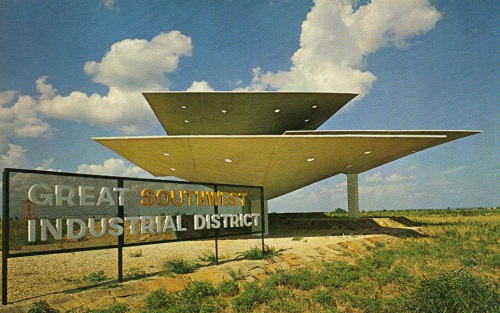 The future is NOW! (click for larger image)
The future is NOW! (click for larger image)
by Paula Bosse
In amongst things the things I’ve haphazardly collected (and I use the term loosely) over the years is this postcard. The image looks familiar to me, as if I remember actually seeing it — but I think that might just be because I’ve looked at this postcard so long. The first thing that popped into my head when I saw it was “turnpike,” but until I read up on the history of local highways (my days are fun-filled!), I wasn’t entirely sure where the turnpike had been other than “the other side of downtown, toward Fort Worth.” Did I ever see this sign and attendant weird looming structures when I was a child? Unless it was still up in the ’70s, I probably didn’t. So what is it?
Here’s the text from the back:
- Concrete wings
- THREE HYPERBOLIC PARABOLOIDS
- GREAT SOUTHWEST INDUSTRIAL DISTRICT
- Midway between Dallas and Fort Worth
- “Located on U.S. 80, these hyperbolic paraboloids stand as insignia of the vast Great Southwest Industrial District in the center of the Dallas-Fort Worth metropolitan area. This thin shell ‘concrete umbrella’ construction form was pioneered in the Untied States by Great Southwest Corporation, developer of a 5500-acre planned industrial district.”
It was somewhere around Arlington and Grand Prairie, back when it was still a vast, undeveloped area being planned in the mid-1950s by Angus Wynne who would, a few years later, bring us Six Flags Over Texas. (US Hwy 80 no longer runs west of Dallas — that stretch is now, I think, Hwy 180 — it was shoved off its Great American Interstate Highway pedestal by the DFW Turnpike and the arrival of what is now Interstate 30.)

1961 (Texas Highways photo by Willis Albarado)
But … “hyperbolic paraboloids”? Those things are so cool. The “hyperbolic paraboloid” was developed by Mexico-based Spanish engineer-architect Felix Candela who worked in the Dallas area with the great architect O’Neil Ford (on, specifically, the Great Southwest Industrial District and the Texas Instruments Semiconductor Building). Candela is pretty interesting — look him up. Without Candela’s paraboloids and his contributions to engineering and architecture, Santiago Calatrava probably wouldn’t be doing the sort of thing that he’s doing.
Here’s another view of (other) paraboloids out on the Texas prairie. They’re like elegant, curved, inverted parasols. Kind of. Made from thin shells of concrete. (One source identified these paraboloids as being part of the Great Southwestern Industrial District and another source as being from the Texas Instruments campus. (See 1958 TI ad below.) Either way, it’s Felix Candela, all the way.)
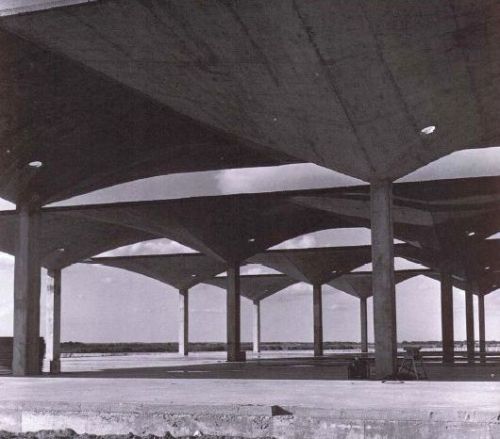
I’m still trying to figure out if I ever saw that fantastic sign and those three silent, looming paraboloids. It’s all pretty cool-looking, and it must have been an unexpected sight in the middle of what was, then, basically nothing.
Speaking of Candela and Calatrava, here’s a photo of the two together:
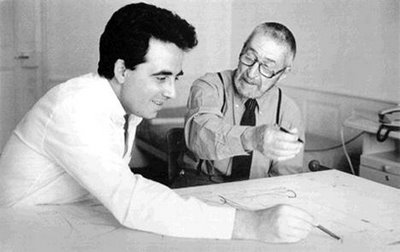
And here’s another paraboloid-y structure that stands out in the DFW area — you might have seen it:
***
Sources & Notes
Photo of Calatrava and Candela from the blog An Engineer’s Aspect, here.
Photo of the Calatrava bridge from Pinterest, here.
A good overview of Felix Candela’s work, with photos and a video, is on the Columbia University website, here.
The Great Southwest Industrial District (Arlington and Grand Prairie) still exists, and their website has a history page which explains its creation and development by Angus Wynne, here.
Lastly, who could resist reading up on just what the heck a “hyperbolic paraboloid” is (warning: math) — Wikipedia’s on it, here.
A 1958 Texas Instruments ad wants you to know that “hyperbolic paraboloids form roof-ceiling” (click to see larger image):
UPDATE: Thanks to comments below, I’m happy to present another photo of the paraboloids, this one from the cover of the 1960 Arlington High School yearbook, complete with Shetland pony! Click the image below to see a larger image of the photo inset. (Thanks to Brad McCorkle for alerting me to the photo — it was taken by his father, Lynn McCorkle, intrepid student photographer!)
ANOTHER UPDATE, from the comments: this still-standing building at 10830 Preston Road (Preston Royal Shopping Center) was one of many that utilized hyperbolic paraboloids in its design. The American Savings Association building (designed by Brock & Mabrey of Corpus Christi, with Braden & Jones of Dallas as associated architects) opened in March, 1966.
*
Copyright © 2014 Paula Bosse. All Rights Reserved.

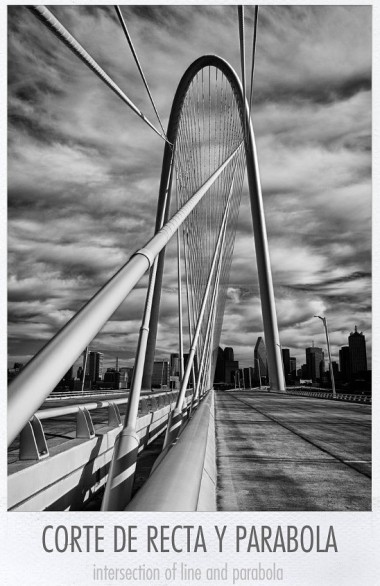
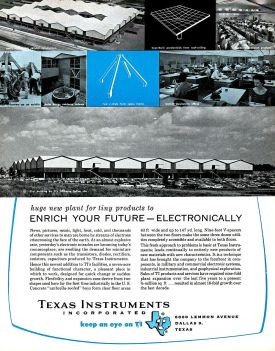
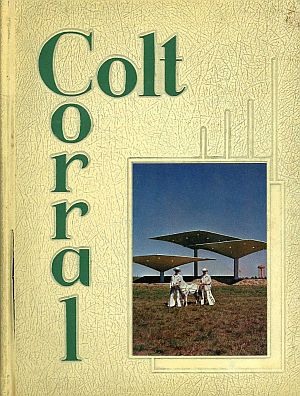

Very cool!
Are you related to my elementary school principal, Edith Bosse?
LikeLike
Thanks! I’ve actually been asked this before, but, no, she’s not a relative. My father’s family is from Indiana.
LikeLike
The three remained at the corner of Division and 360 near Six Flags Mall. Sometime after I moved to Houston, they were torn down, maybe when they redesigned that intersection. I believe there is a photo in the AHS 1963 yearbook. I only know that because my dad, as a student photographer, took the photo.
LikeLiked by 1 person
Cool! I might be able to find that. Is that Adamson or Arlington High School?
LikeLike
Arlington. I have a copy, but it in storage. If you can’t find it, I will look for it once we get moved into our house.
LikeLiked by 1 person
Let me know if you find it. I quickly scanned through the Arlington High School yearbooks for 1963-1966 and didn’t see it.
LikeLike
Maybe it was ’62 or ’61. He graduated in ’63. Maybe it wasn’t his senior year. Now I want to go pull boxes out of storage.
LikeLike
Ha! Don’t worry about it. Whenever you see it again, I’d love to take a look at it!
LikeLike
it was on the cover of the 1960 yearbook
LikeLiked by 1 person
Haha! That’s great!
LikeLike
Great job finding it! I still haven’t unpacked all of my books yet. But, if memory serves, my dad did take that photo. I found out he graduated in ’60, my mom was ’63.
LikeLiked by 1 person
Hey, Brad. I’m adding this photo to the post, because who doesn’t love a Shetland pony/hyperbolic paraboloid combo? I’m putting your father’s name as Lynn McCorkle (the only McCorkle in the AHS 1960 yearbook). If this is incorrect, let me know. Thanks again for mentioning this — I love the photo!
LikeLike
That’s him! Thanks!
LikeLiked by 1 person
do you know of any relation of this project to the bank of america building at 10830 Preston Rd Dallas?
LikeLiked by 1 person
Not a *direct* relation, but it was described as utilizing “hyperbolic paraboloid” design when it opened as the American Savings Association in March, 1966 (architects were Brock & Mabrey of Corpus Christi, with Braden & Jones of Dallas as associated architects). Interestingly, the building has a full basement. Thanks for mentioning this, Kent — I’ve added it to the post. (I’m sending you more details via email.)
LikeLike